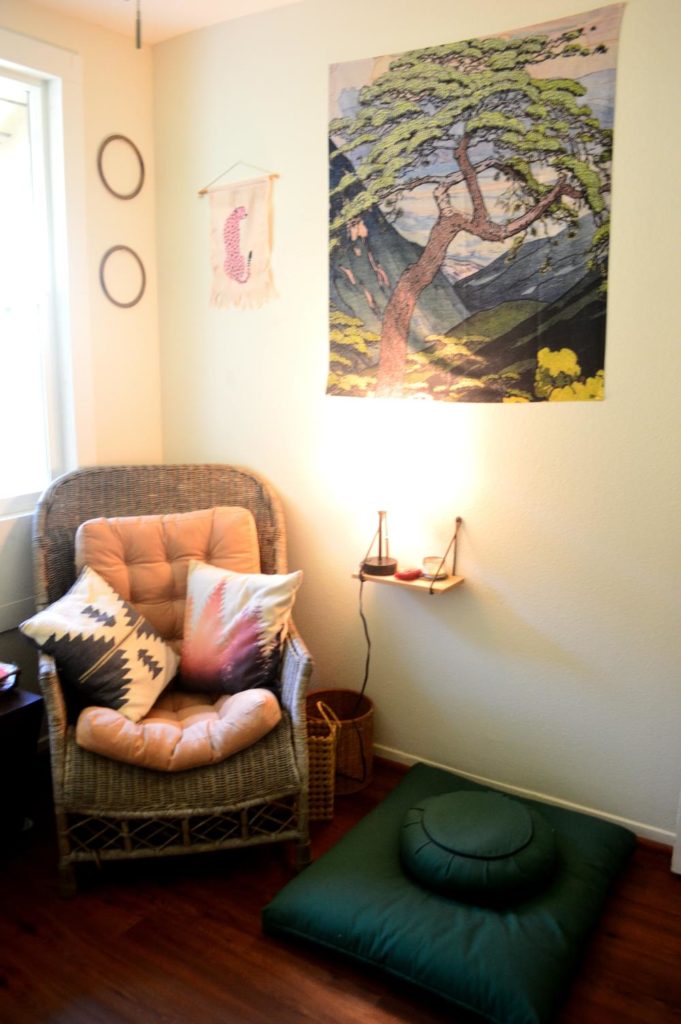Medical providers are using ketamine to treat mental health conditions like depression, anxiety, and PTSD. Can it really help?

It’s not like you wake up one day and decide to take an off-label intramuscular injection once a week for kicks.
No, my choice to take ketamine arose after a discussion with my Zen teacher, a wise man with decades of meditation practice under his belt. For months, I’d sat with him in dokusan (meetings wherein meditators express insights or ask questions), always asking a variation of the same question: Why am I still suffering so much?
Sure, suffering is an inherent quality of life, but it was starting to seem so unreasonable: Really? I thought. This much suffering, though?
One evening, he recommended a podcast about trauma recovery. On the podcast, guests share how they’ve healed with psychedelics, usually after minimal success with antidepressants and therapy. (A quick aside: The word “psychedelic” is not one that many traditional healers use. I hope we can find another term as these medicines become more commonplace.)
Despite a few reservations, I came home from meditation and Googled “psychedelic therapy Honolulu.” Propelled by curiosity, I filled out the intake paperwork for a ketamine clinic right away.

A Little Background
Though we ignore it in daily life, most of us intimately know the situation we are in as human beings. We know we’ll die someday, and we carry this knowledge into our absurd, sometimes mind-numbing day jobs. Terrible things happen beyond reason and without redemption. People who love us hurt us in baffling ways, and we do the same to them. Like countless others, I’ve always found it difficult (sometimes impossible) to be a person while bearing these things in mind.
Sure, I’ve tried therapy. A few counselors were okay; others didn’t feel particularly insightful at all. Eventually, I felt like I was talking myself in circles. Antidepressants were similarly underwhelming. I didn’t want to swallow a pill daily, especially knowing that my pain was likely the result of unresolved wounds, existential fears, and the state of existing on a planet hellbent on self-destruction. The “chemical imbalance” theory of depression never seemed complete to me.
I longed for something to tackle the root of my despair. That’s why I practice Zen and take decent care of myself. It’s also why I’ve visited ashrams of teachers whose realizations, I am sure, have resulted in a state of being that suffering cannot touch.
And yet, the pain was still there. My teacher confessed to me that “Zen doesn’t solve everything,” a statement I found simultaneously disappointing and refreshing.
Once the paperwork went through, I had a Zoom visit with a doctor and a phone call with a paramedic. The staff scheduled my initial dose of ketamine for the first Monday of 2023.

About Ketamine
When used irresponsibly, ketamine can have serious adverse effects. And on a broader level, it’s easy to fall into the mistaken belief that mind-expanding experiences bring us “closer to enlightenment,” God, or whichever words you prefer.
Please note this important information on ketamine as you read this article:
- Ketamine is a Schedule III drug under current DEA guidelines. Schedule III drugs have a moderate to low potential for physical and psychological dependence.
- The FDA has only approved ketamine for use in anesthetic settings, such as in surgery or the ER. Because of this, insurance won’t cover the cost of ketamine when used for mental health. Depending on the clinic, each injection can cost between $200 and $400. This price is prohibitive for a large percentage of the population. Suppose ketamine proves to be a helpful treatment long-term. In that case, we can only hope this classification will change so that those without hundreds of dollars to spare can also experience its benefits.
- Ketamine is only legal when a licensed clinician administers it. It’s safest when used this way, too.
- In surgery, anesthesiologists still use ketamine to sedate patients and help them manage pain. Doctors and nurses have been using the drug since the 70s, but they’ve only recently been using it to specifically treat depression, anxiety, and PTSD.
- So far, research suggests that ketamine helps to increase neuroplasticity. Neuroplasticity is the brain’s natural ability to evolve and create new pathways. Our “depressive thought grooves” may be covered over, rewritten, or shaken up during a ketamine experience.
- Used recreationally (i.e. not in a safe setting for healing), ketamine can be dangerous. It’s a semi-common club drug that can increase heart rate, induce nausea, and elevate blood pressure. Too much ketamine and users can fall into what’s known as “a K-hole.” The K-hole is a state of extreme dissociation, described as a liminal space between being high and being comatose. This sounds like no fun at all.
- The exciting news: If used correctly, ketamine can lift depressive symptoms overnight, often after the first dose. Some say it’s helped them have deeper insights into their patterns and make progress in therapy. After 4–5 infusions or injections (depending on the clinic), some only come back for symptom maintenance every six months or even every few years.
Please seek out licensed professionals if you’re interested in trying ketamine for your mental health.

The Ketamine Experience
I went to the clinic with minimal expectations.
The office was spacious and modern, yet still felt organic. It had several sleekly incorporated wood surfaces, houseplants, and a white noise machine. At my first visit, I gave a urine sample (it’s not safe to mix ketamine with other drugs, especially uppers) before the staff called me back.
Inside the treatment room, I sat in a recliner with a blood pressure cuff around my bicep and a pulse monitor on my finger. A paramedic entered the room, followed by a young woman who offered to either stay with me or leave and observe my experience from outside. Her presence was calming, but I still wanted to be alone.
After the injection (feels like your standard vaccination), I laid back with an eye mask and headphones that were playing ambient music. For over an hour, I let go of my body and drifted into what I perceived to be a vast, blank screen. The thoughts and images that came to me were diverse: funny, profound, confused, and accepting.
I thought of loved ones who’d passed away. I thought of co-workers, my family, and Ramana Maharshi, an Indian sage whose ashram I’d like to revisit. When I returned to my normal state, dizzy and lightheaded, I couldn’t articulate much to the staff who helped me integrate back into everyday life.
The headspace I occupied for the rest of the day was calm. My thoughts were slower to rise and less agitated. I went to the beach, got in the ocean, and sat on my zafu for a while. Gazing at the water from the lookout on Diamond Head, I still kept my expectations low.
I remembered: The first noble truth is that life is suffering.
But the third is that there’s a way out.
After My First Doses of Ketamine
When I woke up the next morning, there was a noticeable difference. Nothing explosive, just a subtly calmer state overall.
It was good to be in my body again. My interactions with others seemed easier, and I felt overall more receptive to the world. I didn’t have to exert so much energy to just be in it. By Wednesday, there was a decrease in that “good” feeling, but still an improvement from before the injection. The clinic staff told me this is normal. Sometimes takes a few doses (they call this process “onboarding”) for a sustained sense of well-being to return.
I’ve since had one more dose, which was less profound than the first, but that’s okay. The experience is not as important to me as the after-effects, which have been positive.
As with all health treatments, there is no “magic cure.” Ideally, medicine helps us help ourselves rather than acting as a crutch while we go on living as we previously were.
While I continue with the onboarding process, I remember that the onus is on me to keep the momentum going: To change things when I need to (even if that means changing everything), to value my relationships, and to continue creating a life worth living.
Get more like this—Sign up for our daily inspirational newsletter for exclusive content!
__
Photo: Colleen via Pixabay; Rusty Johnston; Gordon Johnson; Pixabay; Rusty Johnston





